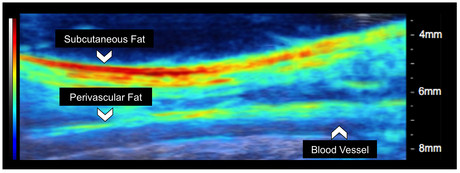Biomedical imaging system combines optical and ultrasound technology

Purdue University researchers are developing a biomedical imaging system that uses photoacoustic tomography — a combination of optical and ultrasound technology — to improve diagnosis of life-threatening diseases.
Photoacoustic tomography is a non-invasive technique that works by converting absorbed optical energy into an acoustic signal. Pulsed light is sent into body tissue, creating a small increase in temperature that causes the tissue to expand and create an acoustic response that can be detected by an ultrasound transducer. The ultrasound data is used to visualise the tissue.
“The nice thing about photoacoustic tomography is the compositional information,” said Craig Goergen, an assistant professor in Purdue’s Weldon School of Biomedical Engineering. “It provides information about where blood and lipid are located, along with other essential information.”
Now, Goergen and his colleagues have developed an adjustable photoacoustic probe that is said to feature improved light delivery and image quality, described in the journal Photoacoustics. The system provides real-time compositional information of body tissue without the need for contrast agents and with better depth penetration compared with conventional optical techniques.

Photoacoustic tomography can be used to detect or monitor a myriad of diseases, including cardiovascular disease, diabetes and cancer. As explained by Goergen, “Trying to diagnose these diseases at an earlier time can lead to improved patient care. We are in the process now of trying to use this enhanced imaging approach with a variety of different applications to see what it can be used for.”
Among other potential uses for photoacoustic tomography is the mapping of lipid deposition within an arterial wall that can cause other health problems, measuring cardiac tissue damage and tumour biopsies. Using photoacoustic tomography for intraoperative tumour biopsies could help surgeons make sure they remove all the cancer from a patient, Goergen said.
One of the challenges of photoacoustic tomography is improving the penetration depth and signal-to-noise ratio past optical absorbers. The researchers believe creating optical manipulation techniques to maximise photon density could provide a solution. As a result, they have created a motorised photoacoustic holder that allows users to easily manoeuvre the aim of the device and tune the depth where light is focused, improving the light penetration depth and signal-to-noise ratio.
The researchers currently have a patent pending for the imaging technology, thanks to the help of the Purdue Office of Technology Commercialization. They are interested in talking with other companies about further possible uses for the technology.
A non-destructive way to locate microplastics in body tissue
Currently available analytical methods either destroy tissue in the body or do not allow...
Rapid imaging method shows how medicine moves beneath the skin
Researchers have developed a rapid imaging technique that allows them to visualise, within...
Fluorescent molecules glow in water, enhancing cell imaging
Researchers have developed a new family of fluorescent molecules that glow in a surprising way,...





